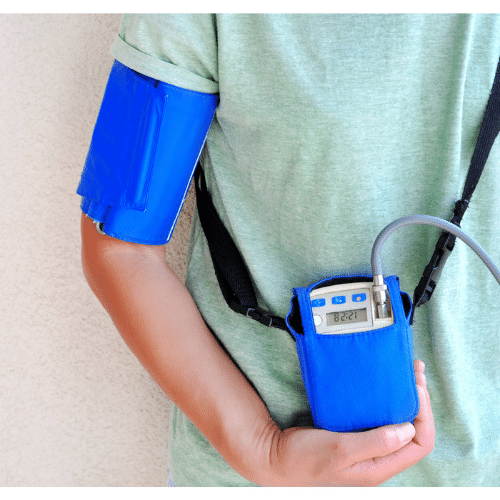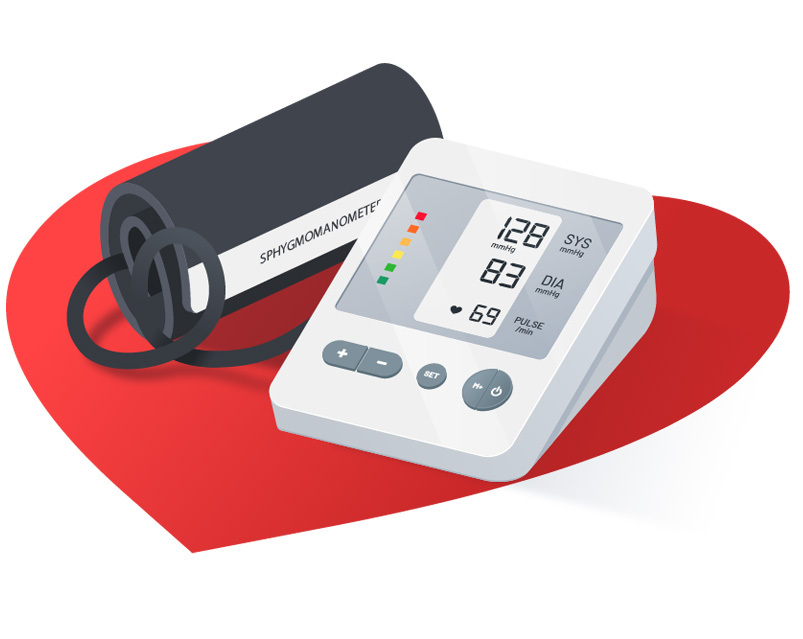The Benefits of the ABPM Examination for Accurate Blood Pressure Assessment
Ambulatory Blood Pressure Monitoring (ABPM) supplies an innovative approach to evaluating high blood pressure. This method provides constant, 24-hour information, catching changes that take place throughout everyday activities and sleep. Such thorough monitoring not only enhances precision however also reveals crucial patterns, aiding to identify in between real hypertension and conditions like white-coat disorder. Understanding these nuances might cause much more effective treatment approaches. What effects might this have for individual treatment and administration?
What Is Ambulatory Blood Pressure Monitoring (ABPM)?
Ambulatory Blood Pressure Monitoring (ABPM) is a method that permits for constant high blood pressure assessment over a 24-hour period, providing a substantial photo of a person's high blood pressure variations. ABPM test in Bangalore. This technique makes use of a mobile tool that immediately measures blood stress at normal periods throughout the day and evening. As individuals deal with their daily activities, the tool records data reflecting their high blood pressure variants during different times and situations, consisting of rest and physical exertion.ABPM is especially beneficial for detecting conditions such as hypertension, as it can compare real hypertension and white-coat syndrome, where patients exhibit raised analyses in scientific setups but not in their daily lives. By providing a detailed view of blood pressure changes, ABPM help doctor in making notified decisions regarding medical diagnosis and therapy. It boosts the understanding of blood pressure patterns, making it possible for customized management approaches for people.
Constant Monitoring for Improved Precision
Constant monitoring of high blood pressure with ABPM significantly improves the precision of readings compared to conventional techniques. This strategy enables high blood pressure measurements at regular periods throughout the day and night, capturing fluctuations that may happen as a result of daily activities, anxiety, or other elements. Unlike single readings taken throughout a facility browse through, ABPM offers a thorough account of a patient's high blood pressure over a 24-hour period.This continuous assessment results in much more reputable information, enabling medical care carriers to identify patterns and potential issues that may go undetected with sporadic dimensions. It likewise assists compare real hypertension and white-coat syndrome, where people display elevated readings due to anxiousness in a clinical setup. By leveraging the advantages of constant monitoring, ABPM substantially improves diagnosis and treatment techniques, ultimately contributing to much better individual outcomes and more customized healthcare approaches.
Comprehending Blood Pressure Irregularity
Blood pressure variability refers to the changes in blood pressure readings that can occur over time because of various variables, consisting of physical task, stress and anxiety, and body clocks. This irregularity is significant as it provides understandings right into a person's cardio wellness. ABPM test in Bangalore. For example, elements such as workout can temporarily raise high blood pressure, while relaxation may result in a decline. Additionally, the body's natural rhythms can create high blood pressure to differ throughout the day, commonly being reduced during the night and higher throughout waking hours. High levels of irregularity have been related to raised risks of cardiovascular occasions, making it essential for medical care professionals to keep track of these variations. Understanding blood stress irregularity aids in tailoring treatment plans and assessing general wellness. Accurate appraisal with approaches like Ambulatory Blood Pressure Monitoring (ABPM) can capture these variations, enabling an extra complete examination of a person's blood stress profile
Recognizing White Coat Hypertension
White coat high blood pressure, commonly referred to as white layer disorder, is defined by raised blood pressure readings in clinical settings as a result of stress and anxiety or tension. Recognizing its signs and symptoms and signs is important for accurate medical diagnosis, as misconception can cause unnecessary treatments. Comprehending this sensation is crucial for effective high blood pressure administration and individual care.
Understanding White Coat Disorder
Although lots of individuals display elevated blood stress readings in clinical setups, this sensation, known as white layer high blood pressure, can obscure real state of their cardio health. This problem occurs when people experience anxiety or stress throughout medical sees, resulting in short-term spikes in high blood pressure. Consequently, medical care service providers might misunderstand these readings as a measure of hypertension. White layer syndrome highlights the significance of accurate blood stress analysis, as counting only on in-office dimensions can result in unnecessary treatments or mistaken beliefs concerning a client's wellness. Recognizing this syndrome is important for clinicians, as it highlights the need for alternative monitoring approaches, such as ambulatory blood pressure monitoring (ABPM), to acquire an extra accurate representation of a client's high blood pressure levels.
Signs and symptoms and Indicators
Several people may experience certain symptoms that suggest the existence of white layer hypertension. These symptoms can consist of elevated blood stress readings during medical visits, come with by feelings of anxiety or nervousness in a professional atmosphere. Individuals frequently report a rapid heartbeat or sweating when connecting with health care specialists, which might exacerbate their high blood pressure degrees. Furthermore, some individuals may observe a variation in between their in-office additional resources high blood pressure analyses and those taken in your home, where they really feel extra relaxed. Recognizing these signs is crucial, as they can suggest that stress or anxiousness related to clinical settings is affecting their blood pressure. Understanding these indicators can help in determining white coat hypertension and figuring out the necessity for further assessment.

Value of Accurate Medical Diagnosis
Properly diagnosing white coat hypertension is vital for effective blood pressure management. This problem happens when a person displays elevated high blood pressure readings in a clinical setup due to anxiety or stress, while regular readings are taped in a much more relaxed environment. Misdiagnosis can bring about unnecessary therapy, exposing clients to possible drug adverse effects without any kind of genuine wellness advantage. Making use of ambulatory high blood pressure monitoring (ABPM) is very important in differentiating true hypertension from white layer disorder. ABPM provides continuous blood stress measurements over 24-hour, enabling a comprehensive analysis that can help doctor make notified decisions. Inevitably, exact recognition of white coat high blood pressure warranties clients get appropriate treatment and avoids the pitfalls of mismanagement.
Analyzing Nocturnal Blood Pressure Patterns
Assessing nocturnal high blood pressure patterns is essential for understanding an individual's general cardiovascular health. Nighttime dimensions can expose considerable fluctuations in high blood pressure, which may suggest hypertension irregularity. Furthermore, these patterns are closely correlated with heart health and wellness, highlighting the value of continual monitoring past typical office check outs.
Significance of Nighttime Measurements

Nighttime high blood pressure measurements are typically crucial for comprehending a person's total cardiovascular health. These analyses offer crucial understandings into just how high blood pressure behaves throughout rest, which can vary considerably from daytime levels. Keeping track of nocturnal blood stress enables YOURURL.com the identification of unusual patterns, such as non-dipping or reverse-dipping phenomena, which may indicate an increased risk for cardiovascular events. Additionally, nighttime assessments can help review the efficiency of antihypertensive therapies, making sure that medicines are appropriately managed. By capturing high blood pressure modifications throughout the night, medical care professionals can develop more personalized treatment strategies, inevitably enhancing individual outcomes and minimizing the likelihood of lasting issues related to hypertension. This emphasizes the significance of extensive high blood pressure assessment throughout the day and evening.
Spotting High Blood Pressure Irregularity
Just how can the variability of nighttime blood stress patterns educate hypertension administration? The assessment of nocturnal blood stress with the Ambulatory Blood Pressure Monitoring (ABPM) examination reveals essential changes that commonly go unnoticed in standard measurements. These patterns can indicate the existence of "non-dipping" high blood pressure, where blood stress fails to go down during rest, suggesting an enhanced cardiovascular risk. By identifying such variability, doctor can customize interventions better, changing treatment plans based on the individual's certain nighttime blood stress habits. Recognizing these patterns also help in examining the efficiency of antihypertensive medicines, guaranteeing that patients attain optimal blood stress control throughout the day and evening. Subsequently, nocturnal analysis comes to be vital in complete high blood pressure management.
Connection With Heart Health And Wellness
Recognizing nocturnal high blood pressure patterns not just help in hypertension monitoring yet additionally has significant implications for heart wellness. Study shows that irregular nocturnal high blood pressure analyses, such as non-dipping or reverse dipping patterns, are related to boosted cardio dangers. Throughout rest, blood pressure normally declines, a phenomenon important for cardio recovery. When this decline is missing, it may signify underlying problems such as autonomic dysfunction or increased arterial rigidity. Furthermore, people with elevated nighttime blood pressure go to a heightened risk for cardiac arrest and stroke. Utilizing ambulatory blood pressure monitoring (ABPM) to examine these nighttime patterns can offer essential understandings, enabling for customized treatments that better protect heart health and wellness and enhance overall client outcomes.
Tailoring Treatment Plans Based Upon Real-Life Information
Tailoring therapy plans based additional info on real-life information entails leveraging continuous high blood pressure keeping an eye on to create individualized medical care techniques. The Ambulatory Blood Pressure Monitoring (ABPM) examination supplies a detailed account of a person's high blood pressure variants throughout everyday tasks. This in-depth data enables doctor to identify patterns that may be forgotten in typical workplace visits.By evaluating fluctuations in blood stress during various times and problems, clinicians can change drugs, dosages, and lifestyle suggestions to far better match specific person demands. This individualized approach not just enhances the performance of treatment strategies however likewise minimizes the likelihood of adverse reactions to medications.Furthermore, real-life data can disclose prospective triggers for high blood pressure, resulting in aggressive treatments. Generally, customizing treatment based upon continuous monitoring cultivates an extra reliable, patient-centered technique to taking care of high blood pressure and enhancing long-term health and wellness results.
Boosted Client Compliance and Involvement
While conventional monitoring approaches may restrict client participation, using Ambulatory Blood Pressure Monitoring (ABPM) substantially improves individual compliance and engagement in their own healthcare. By enabling people to wear a portable tool that tape-records high blood pressure over 24-hour, ABPM empowers individuals to take an active role in their wellness administration. This continual monitoring gives a more extensive sight of blood stress fluctuations, encouraging individuals to understand their problem better.Moreover, ABPM promotes an atmosphere where clients can review their readings with health care suppliers more meaningfully, causing notified decision-making. Patients end up being more invested in adhering to suggested therapies and lifestyle modifications when they see real-time information reflecting their health and wellness standing. The shift from passive individual to energetic collaborator not only enhances conformity but additionally boosts general health and wellness end results, making ABPM a beneficial device in promoting patient engagement in hypertension management.
Frequently Asked Questions
For how long Does an ABPM Examination Usually Last?
The ABPM test typically lasts 1 day. During this duration, it measures high blood pressure at normal intervals, giving an extensive analysis of a client's high blood pressure patterns throughout their everyday tasks and sleep.
Are There Any Type Of Risks Related To ABPM Screening?

Can ABPM Be Used for Children and Teenagers?
ABPM can be used for children and teenagers, supplying crucial understandings right into their high blood pressure patterns. Proper tools sizing and interpretation by experienced specialists are imperative to guarantee exact analyses and stay clear of misdiagnosis.
Just How Is ABPM Different From Standard Blood Pressure Monitoring?
ABPM differs from standard monitoring by providing constant high blood pressure analyses over 1 day, recording variations throughout daily tasks and sleep, whereas conventional methods frequently count on single measurements, potentially missing important changes in high blood pressure.
What Should Clients Do During the ABPM Test?
During the ABPM examination, people need to maintain typical activities while staying clear of hefty exercise, too much caffeine, and smoking. They need to also keep their arm still when the gadget blows up, making sure precise readings throughout the monitoring duration.